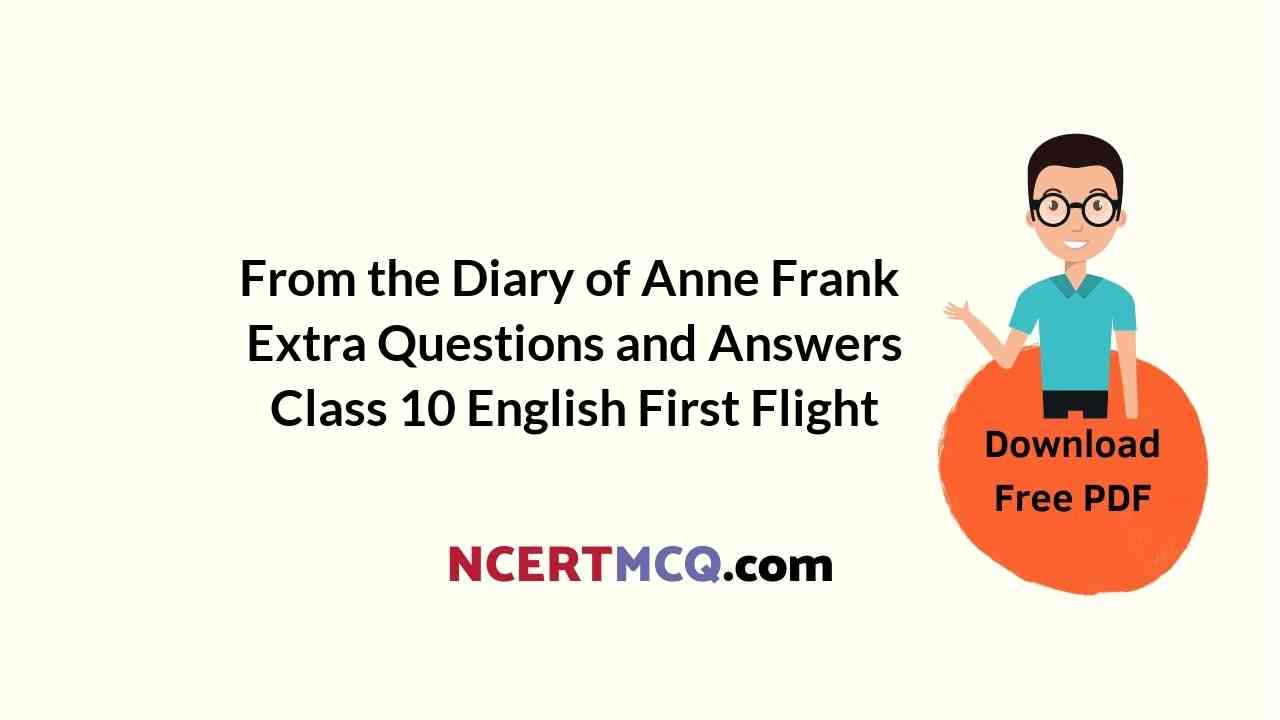Here we are providing The Trees Extra Questions and Answers Class 10 English First Flight, Extra Questions for Class 10 English was designed by subject expert teachers. https://ncertmcq.com/extra-questions-for-class-10-english/
The Trees Extra Questions and Answers Class 10 English First Flight
The Trees Extra Questions and Answers Short Answer Type
The Trees Class 10 Extra Questions Question 1.
Why do the trees need to move out? Where have they been and why?
Answer:
The trees in the forest have been cut and man has planted trees in his courtyard for his selfish decorative purposes. It makes the trees feel suffocated and out of place. So they need to move out into the forest. They have been in the city houses as men have imprisoned them there.
The Trees Class 10 Extra Questions And Answers Question 2.
What makes the forest empty? What cannot happen in a-treeless forest?
Answer:
Man’s cutting the trees of the forest at an uncontrollable speed has resulted in the empty forests. In a treeless forest, birds and insects cannot find shelter and make their homes there. The sun cannot cool its rays in the shadow there.
The Trees Become Leafless Due To Question 3.
How do the trees rebel against their imprisonment at the hand of the man?
Answer:
Man has imprisoned the trees of the forest in his houses in cities. The trees rebel against their imprisonment. The roots come out of the floors by breaking them. The leaves come out of the windows by breaking the glasses. The long cramped branches start expanding themselves. Thus, the trees move out into the forest.
The Trees Poem Class 10 Extra Questions Answers Question 4.
What kind of whispers can the poet hear? Why will these be silent tomorrow?
Answer:
The poet can hear the voices of the trees talking to each other, asserting their right to be free and the sounds of their moving out. It may also be her inner voice that reprimands her for imprisoning the trees. The whispers will be silent tomorrow as the trees will move out into the forest and will be free.
The Trees Extra Questions And Answers Question 5.
What does the poetess compare the bough with and why?
Answer:
The boughs are long and cramped. The poet compares the boughs with the patients who have been recently discharged and are moving out of the clinic doors because the boughs also move out in the same semi-dazed state as if they are under a spell.
The Tree Become Leafless Due To Question 6.
The poem ‘The Trees’ presents a conflict between Man and Nature. Discuss.
Answer:
The poem ‘The Trees’ presents the rebellion of the tree against the human oppression and imprisonment within walls. The forest is the natural habitat of the trees. The trees feel suffocated in houses. They rebel against it and move out.
The Trees Class 10 Questions And Answers Question 7.
Why is the poet writing long letters? Why does she not mention the departure of the trees?
Answer:
The poet can feel the sorrow of the trees imprisoned in the cities. So, she is writing long letters or poems voicing the trees’ right to be in their natural habitat i.e., the forest. She does not mention the departure of the trees in her letters as she is too embarrassed for imprisoning them ever.
Trees Extra Questions Question 8.
How does the changing forms of moon relate to the moving out of the trees?
Answer:
The moon also changes its forms with the moving out of the trees. In a treeless forest it appears as a whole, closed body. But with the trees moving out into the forest, the moon also appears as a broken mirror. Its pieces flash light on the tallest of trees.
Trees Poem Extra Questions Question 9.
Describe the symbolism in the poem “The Trees”.
Answer:
The poet uses trees as a metaphor for human beings. The human beings feel suffocated and sad under the oppression and dependence. They yearn for their freedom and independence. They rebel against the oppression, slavery and exploitation to be free and be on their own. The trees also rebel against imprisonment to return to the forest. Thus, they are apt symbol for human beings.
The Trees Became Leafless Due To Question 10.
Conflict between human and nature is always there. Nature is also rebelling against civilization and becoming destructive. Explain.
OR
A conflict between man and nature is going on, in this civilization pursuit, men are disregarding the natural growth of plants and trees. In total confinement, nature also rebels against civilization and becomes destructive. Elaborate.
Answer:
Man has been destroying nature due to personal and material pursuits. He is endlessly playing havoc with nature. He is trying to harness wind, solar energy and flora. In this pursuit man has forgotten that excessive destruction can carry us to any situation. Man is cutting trees and destroying the natural habitat. This is causing global warming with overall rise in temperature. If these practices go unchecked, we might soon be drowned due to melting of ice from polar caps. Man should wake up and save the planet earth from destructive forces of nature.
The Trees Question Answer Question 11.
The trees in the poem stretch out their branches, break remove common barriers and struggle hard even out in the open in their natural environment. Analyze the efforts one puts into breaking sway captivity and striving for freedom.
OR
Freedom is the basic theme of happiness for all creatures as well as plants. Explain this statement with reference to the struggle of the branches to come out in open in the veranda of the poet’s house.
Answer:
It is true that freedom is the basic theme of happiness in this universe. Freedom is the true law of nature. This idea can be found everywhere and in all spheres, even the palace of gold is useless without freedom. We have read about so many national heroes who have sacrificed their everything for freedom and to make their country free. Freedom is the very first need for all for human beings as well as for animals. “
In this poem, the poet has described the deep feelings of the trees that want to become free from human beings’ prison. The description of struggle made by the branches to come out in open from the floor is too real and heart touching. The trees don’t want to live in these surroundings. So they do their best to come out of the floor and window.
The Trees Class 10 Solutions Question 12.
After reading the poem ‘The Trees’ we come to conclude a definite point that there is clear conflict between nature and human beings and the reason is behaviour of human beings. Describe.
Answer:
Man’s cutting the trees of the forest at an uncontrollable speed has resulted in the empty forests. In a treeless forest, birds and insects cannot find shelter and make their homes there. The sun cannot cool its rays in the shadow there.
Question 13.
(i) Find, in the first stanza, three things that cannot happen in a treeless forest.
(ii) What picture do these words create in your mind: … “sun bury its feet in shadow…”?
(ii) What could the poet mean by the sun’s ‘feet”?
Answer:
(i) The three things that cannot happen in a treeless forest Eire the sitting of a bird on tree, the hiding of insects and the sun burying its feet in the shadow of the forest.
(ii) The sun radiates heat and the given words create a picture of the hot, radiating sun cooling its feet in the cool shadow of the forest. The sun’s feet refer to its rays that reach the earth.
Question 14.
(i) Where are the trees in the poem? What do their roots, their leaves and their twigs do?
(ii) What does the poet compare their branches to?
Answer:
(i) In the poem, the trees are in the poet’s house. Their roots work all night to disengage themselves from the cracks in the veranda floor. The leaves make efforts to move towards the glass, while the small twigs get stiff with exertion.
(ii) The poet compares the ‘long-cramped’ branches that have been shuffling under the roof to newly discharged patients who look half-dazed as they move towards the hospital doors after long ill¬nesses and wait to get out of the hospital. The branches also have cramped under the roof and want to get out into the open to spread themselves in fresh air.
Question 15.
(i) How does the poet describe the moon:
(a) at the beginning of the third stanza, and
(b) at its end? What causes this change?
(ii) What happens to the house when the trees move out Of it?
(iii) Why do you think the poet does not mention “the departure of the forest from the house” in her letters? (Could it be that we are often silent about important happenings that are so unexpected that they embarrass us? Think about this again when you answer the next set of questions.)
Answer:
(i) (a) In the beginning of the third stanza of the poem “The Trees”, the poet describes the moon at its perfection. She tells us that full moon shines in an open sky.
(b) In the end of the third stanza, the poet describes that the moon is broken like a mirror. The cause of this change is that the poet imagines that the forest or trees and plants are moving out from her home. When the forest was in her home the moon seemed full to her. But when the trees are moving out of the house into the forest, the moon seems fragmented to her.
(ii) When the trees move out of the house, the poet feels that the glass is breaking and the trees are partially falling towards the front in the night. Winds rush to meet and welcome the trees.
(iii) When the trees are moving out of the poet’s house, she is writing long letters. But in the letters the poet does not mention about the departure of the forest from the house. I think the poet does not mention about moving out of the trees because howsoever she may not want it, yet it happened so hastily and unexpectedly that she felt embarrassed. That is why she could not mention about it in her letter.
Question 16.
Now that you have read the poem in detail, we can begin to ask what the poem might mean.
Here are two suggestions. Can you think of others?
(i) Does the poem present a conflict between man and nature? Compare it with A Tiger in the Zoo. Is the poet suggesting that plants and trees, used for ‘interior decoration’ in cities while forests are cut down, are ‘imprisoned’, and need to ‘break out’?
(ii) On the other hand, Adrienne Rich has been known to use trees as a metaphor for human beings; this is a recurrent image in her poetry. What new meanings emerge from the poem if you take its trees to be symbolic of this particular meaning?
Answer:
(i) The poem “The Trees’ depicts the serious problem of deforestation worldwide, which causes ecological imbalances and the risk of global warming. The poet means to say that we are depriving the forest of their trees and creating concrete jungles in the cities. The irony of the situation is that we are decorating our homes and cities with trees and plants and cutting the trees from the forest. If we compare this poem to another poem, ‘A Tiger in the Zoo’, we find many similarities.
We imprison the tigers and other animals in the zoo whereas their true places is in the forest. Similarly, we ‘imprison’ the trees and plants in our houses and cities whereas their true place is in the forests. There is nothing wrong with decorating the houses and cities with the plants and trees. But it is something unpardonable to deprive the forests of the trees and plants. That is why the poet imagines that the trees from the houses want to be liberated and move to the forest.
(ii) There is another aspect of this beautiful poem. Adrienne Rich in many of her poems has used trees as a metaphor for human beings. So, if we think of the poem from this point of view, it signifies that human beings are constantly going away from the country life. Everybody seems to settle in big cities where we are deprived of the qualities of enjoying nature in its various forms. Migration of more and more people towards city life creates a vacuum in the minds of such human beings. So, they crave and long for moving to natural surrounding. They earnestly and eagerly desire to go back to nature.
The Trees Extra Questions and Answers Reference to Context
Read the following stanza and answer the questions that follows:
Question 1.
The trees inside are moving out into the forest,
the forest that was empty all these days where no bird could sit no insect hide
no sun bury its feet in shadow
the forest that was empty all these nights
will be full of trees by morning.
(i) Name of poem and poet.
(ii) From where do the trees move out into the forest?
(iii) Why has the forest been empty all these days?
(iv) How do you think will the forest be full of trees again?
Answer:
(i) These lines have been taken from the poem ‘The Trees’ composed by ‘Adrienne Rich’.
(ii) The trees move out into the forest from the human houses.
(iii) The forest has been empty all these days because trees have been cut and transported to the cities.
(iv) The forest would be again full of trees when men would understand his responsibility towards the nature.
Question 2.
All night the roots work
to disengage themselves from the cracks
in the veranda floor.
The leaves strain towards the glass
small twigs stiff with exertion
long-cramped boughs shuffling under the roof
like newly discharged patients
half-dazed, moving
to the clinic doors.
(i) What are the roots trying to do?
(ii) Why are the small twigs stiff?
(iii) What does the poet mean by ‘the clinic doors”?
(iv) Name the poem and poet.
Answer:
(i) The roots are trying to break the veranda floor.
(ii) The small twigs are stiff as they were straining to break the glass.
(iii) The poetess means that the trees are sick because they are being suffocated and choked in cramped spaces of the veranda.
They need to be cured and become healthy again and for them the clinic is the open spaces of the forest.
(iv) The poem “Trees” composed by ‘Adrienne Rich’.
Question 3.
I sit inside, doors open to the veranda
writing long letters
in which I scarcely mention the departure of the forest from the house.
The night is fresh, the whole moon shines
in a sky still open
the smell of leaves and lichen
still reaches like a voice into the rooms.
(i) Where is the speaker?
(ii) Why does the poet not mention the departure of the forest?
(iii) How do the leaves and lichen talk to each other?
(iv) Name the poem and poet.
Answer:
(i) The speaker (poetess) is sitting inside her house
(ii) The poetess doesn’t mention the departure of the forest because she is embarrassed.
(iii) The leaves and lichen talk to each other through the smell.
(iv) The poem “Trees” composed by Adrienne Rich.
Question 4.
My head is full of whispers
which tomorrow will be silent.
Listen. The glass is breaking.
The trees are stumbling forward
into the night. Winds rush to meet them.
The moon is broken like a mirror,
its pieces flash now in the crown
of the tallest oak.
(i) What are ‘whispers’ that the poetess can hear?
(ii) What does the poet ask us to listen to?
(iii) Which poetic device has been used?
(iv) Name the poem and poet.
Answer:
(i) The whispers that the poetess can hear are the sounds made by the outgoing trees.
(ii) The poetess asks us to listen to the sounds of the breaking glass.
(iii) The poetic device is ‘Personification’. The trees are personified.
(iv) The poem “Trees” written by ‘Adrienne Rich’











